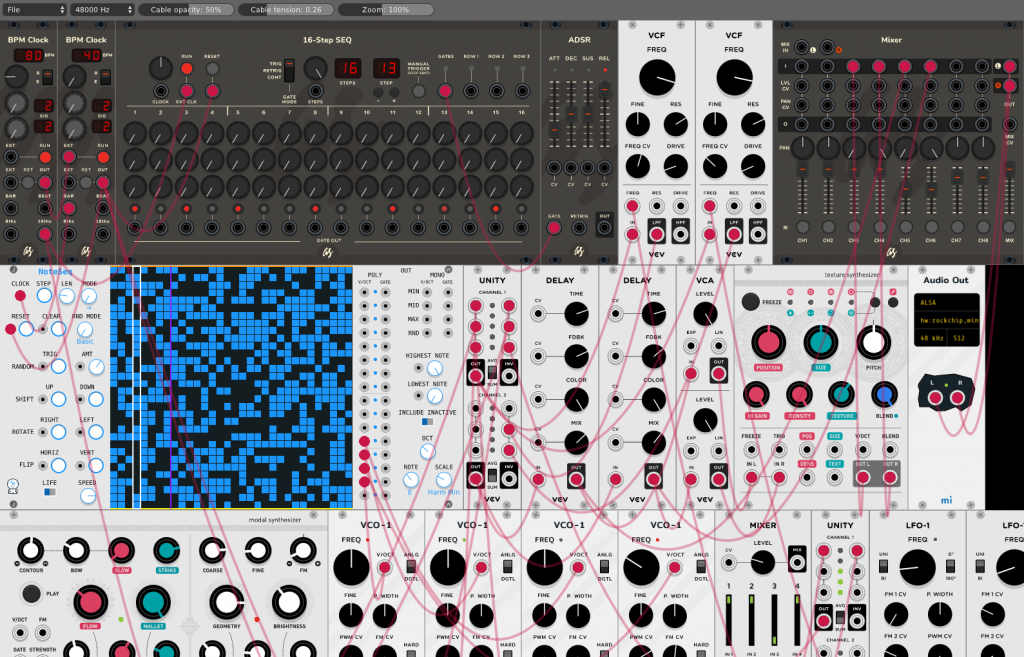Try a web version - requires a modern browser (Chrome for MIDI input).
miRack is a fork of VCVRack (an open-source virtual modular synthesizer) with optimisations and tweaks primarily targeting Raspberry Pi, ASUS Tinker Board and similar hardware, as well as iOS and Web. Can be used on desktop systems as well.
Rack itself is the main application/engine/plugin host. See below for information about plugins implementing actual modules.
miRack is a work in progress. Some features are broken or deliberately turned off. Read carefully below.

-
Reworked and greatly optimised user interface rendering, layout and event handling.
-
Multithreaded audio/signal processing.
-
Individual plugins are being forked and optimised if it is necessary.
-
Only stereo audio output is supported. VCVRack Bridge is not supported. A patch will not run unless there's an Audio Out module with a valid output device. This is likely to be improved in future but is not a high priority task at the moment.
-
Engine sample rate must match the audio output sample rate (and will change automatically when changing the output sample rate). Some modules have been configured to work most efficiently when the sample rate is set to 48000 Hz, which should be used to avoid CPU-intensive resampling. When loading existing patches, make sure that engine and audio output sample rates match.
-
Some visual effects are turned off or simplified. This may change in future, but in general due to constrained CPU resources, audio processing and UI performance is the main priority.
Currently, the development is done using ASUS Tinker Board, with Raspberry Pi 3 being the second main supported platform. There's a lot of similar ARM-based boards that should work too. On the desktop, the development is done on macOS, and I guess Linux should be supported as well but it's not being tested.
OpenGL ES will be used on ARM boards for rendering, OpenGL will be used on desktops.
ARM-based hardware is not able to run complex patches that are possible on a desktop. Some modules may perform better and some worse. Only a few of the plugins have been checked for possible optimisations and optimised so far. See below and ensure to install an optimised version if it's available.
Currently, Rack will spawn 3 audio processing threads (because Raspberry Pi and Tinker Board have 4 CPU cores) and will attempt to assing higher priority to them (requires the user to have appropriate permissions). More details on configuring operating system for better performance and to ensure uninterrupted audio will be added later.
Please note that Tinker Board that I'm currently using for development is about twice faster than Raspberry Pi 3. Also, make sure your board has proper active cooling. Without it, all these boards get quite hot under heavy load and that will cause CPU frequency to reduce very quickly.
When configuring Audio Out module, choose "hw:rockchip,miniarm-codec,0" for HDMI output, and "hw:USB Audio OnBoard,2" for 3.5mm jack output.
Due to some issues with Xorg, the framerate is less than the hardware can achieve. Support for running without an X server is in development.
Raspberry Pi 3 is supported. I don't expect any good results with older models.
GL driver must be enabled either manually via config.txt or using raspi-config (Advanced Options -> GL Driver).
Right click the volume icon on the desktop taskbar to switch between HDMI and 3.5mm jack audio output.
VCVRack plugins are source-compatible with miRack. There may be issues with individual plugins, but the ultimate goal is to maintain source code compatibility. However plugins are not binary-compatible, so closed-source plugins are not supported. This is unlikely to change in the future, although existing binaries would not work on ARM-based boards anyway.
Some plugins have been forked to include optimisations and tweaks. See (VCVRack plugin list](https://vcvrack.com/plugins.html) and Installing Plugins section below.
On Debian-based systems (TinkerOS, Raspbian and most other) running on ARM boards, APT package manager can be used to install and update miRack and plugins. This is the preferred method as it ensures that all installed plugins are updated when it is required to maintain compatibility with the main Rack application. Please see here for repository configuration and installation instructions.
When cloning this repository, use --recursive option, or do git submodule update --init --recursive.
Assuming you have the basic tools (GCC and make on Linux, Xcode and Homebrew on macOS), execute make prereq. This will attempt to automatically install the required packages on Debian-based distros (Tinker OS and Raspbian) and macOS.
Build dependencies with make dep, and then build Rack with make.
Install Fundamental module pack with make +Fundamental to have several basic modules to start with.
To run Rack, execute make run.
There's a list of plugins that can be viewed by executing make list-plugins. To install plugins, execute make +PluginSlug +PluginSlug .... You will get the slugs from the list, and also they are shown by Rack when you try to open a patch that uses modules from missing plugins. Also, you can install all plugins at once with make +all.
Again, most of the plugins have not been tested and may or may not be usable on ARM hardware in their current states (and some may fail to build).
Installing plugins this way ensures that an optimised version will be installed if it's available.
Also, since miRack is under active development, plugins need to be rebuilt when miRack is updated. This can be done for all installed plugins at once by executing make allplugins.
Clone a plugin repository into a folder inside plugins folder. Use --recursive option, or do git submodule update --init --recursive afterwards.
To build, execute make -C plugins/PLUGIN_FOLDER. No installation is required.
All source code in this repository is licensed under BSD-3-Clause.
Component Library graphics in res/ComponentLibrary are licensed under CC BY-NC 4.0 by Grayscale. Commercial plugins must request a commercial license to use Component Library graphics by emailing contact@vcvrack.com.